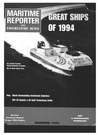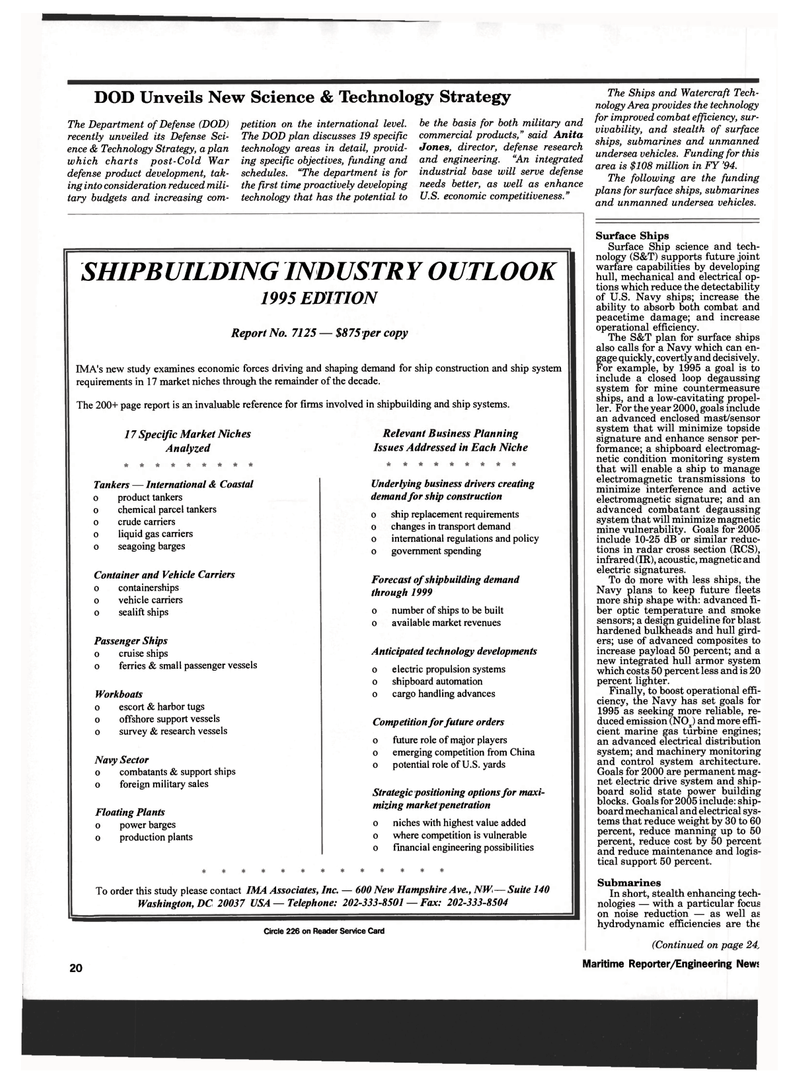
Page 18: of Maritime Reporter Magazine (December 1994)
Read this page in Pdf, Flash or Html5 edition of December 1994 Maritime Reporter Magazine
DOD Unveils New Science & Technology Strategy
The Department of Defense (DOD) recently unveiled its Defense Sci- ence & Technology Strategy, a plan which charts post-Cold War defense product development, tak- ing into consideration reduced mili- tary budgets and increasing com- petition on the international level.
The DOD plan discusses 19 specific technology areas in detail, provid- ing specific objectives, funding and schedules. "The department is for the first time proactively developing technology that has the potential to be the basis for both military and commercial products," said Anita
Jones, director, defense research and engineering. "An integrated industrial base will serve defense needs better, as well as enhance
U.S. economic competitiveness."
The Ships and Watercraft Tech- nology Area provides the technology for improved combat efficiency, sur- vivability, and stealth of surface ships, submarines and unmanned undersea vehicles. Funding for this area is $108 million in FY '94.
The following are the funding plans for surface ships, submarines and unmanned undersea vehicles.
SHIPBUILDING INDUSTRY OUTLOOK 1995 EDITION
Report No. 7125 — $875 per copy
IMA's new study examines economic forces driving and shaping demand for ship construction and ship system requirements in 17 market niches through the remainder of the decade.
The 200+ page report is an invaluable reference for firms involved in shipbuilding and ship systems. 17 Specific Market Niches
Analyzed
Tankers — International & Coastal o product tankers o chemical parcel tankers o crude carriers o liquid gas carriers o seagoing barges
Container and Vehicle Carriers o containerships o vehicle carriers o sealift ships
Passenger Ships o cruise ships o ferries & small passenger vessels
Workboats o escort & harbor tugs o offshore support vessels o survey & research vessels
Navy Sector o combatants & support ships o foreign military sales
Floating Plants o power barges o production plants
Relevant Business Planning
Issues Addressed in Each Niche
Underlying business drivers creating demand for ship construction o ship replacement requirements o changes in transport demand o international regulations and policy o government spending
Forecast of shipbuilding demand through 1999 o number of ships to be built o available market revenues
Anticipated technology developments o electric propulsion systems o shipboard automation o cargo handling advances
Competition for future orders o future role of major players o emerging competition from China o potential role of U.S. yards
Strategic positioning options for maxi- mizing market penetration o niches with highest value added o where competition is vulnerable o financial engineering possibilities
To order this study please contact IMA Associates, Inc. — 600 New Hampshire Ave., NW—Suite 140
Washington, DC 20037 USA — Telephone: 202-333-8501 — Fax: 202-333-8504
Circle 226 on Reader Service Card 20
Surface Ships
Surface Ship science and tech- nology (S&T) supports future joint warfare capabilities by developing hull, mechanical and electrical op- tions which reduce the detectability of U.S. Navy ships; increase the ability to absorb both combat and peacetime damage; and increase operational efficiency.
The S&T plan for surface ships also calls for a Navy which can en- gage quickly, covertly and decisively.
For example, by 1995 a goal is to include a closed loop degaussing system for mine countermeasure ships, and a low-cavitating propel- ler. For the year 2000, goals include an advanced enclosed mast/sensor system that will minimize topside signature and enhance sensor per- formance; a shipboard electromag- netic condition monitoring system that will enable a ship to manage electromagnetic transmissions to minimize interference and active electromagnetic signature; and an advanced combatant degaussing system that will minimize magnetic mine vulnerability. Goals for 2005 include 10-25 dB or similar reduc- tions in radar cross section (RCS), infrared (IR), acoustic, magnetic and electric signatures.
To do more with less ships, the
Navy plans to keep future fleets more ship shape with: advanced fi- ber optic temperature and smoke sensors; a design guideline for blast hardened bulkheads and hull gird- ers; use of advanced composites to increase payload 50 percent; and a new integrated hull armor system which costs 50 percent less and is 20 percent lighter.
Finally, to boost operational effi- ciency, the Navy has set goals for 1995 as seeking more reliable, re- duced emission (NOx) and more effi- cient marine gas turbine engines; an advanced electrical distribution system; and machinery monitoring and control system architecture.
Goals for 2000 are permanent mag- net electric drive system and ship- board solid state power building blocks. Goals for 2005 include: ship- board mechanical and electrical sys- tems that reduce weight by 30 to 60 percent, reduce manning up to 50 percent, reduce cost by 50 percent and reduce maintenance and logis- tical support 50 percent.
Submarines
In short, stealth enhancing tech- nologies — with a particular focus on noise reduction — as well as hydrodynamic efficiencies are the (Continued on page 24,
Maritime Reporter/Engineering News

 17
17

 19
19
